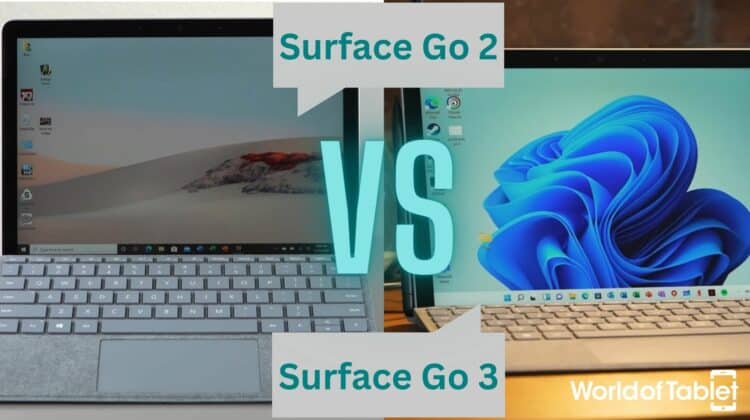
To answer the question right away, it’s not worth upgrading. I compared the Microsoft Surface Go 2 and the Surface Go 3 in detail, and this Surface Go 2 vs Surface Go 3 comparison is the result. My verdict: another marketing ploy aimed at turning a profit without real benefit for you, the consumer. I’m not saying they’re not good devices, just that there is no point in switching from a Surface Go 2 to a Go 3.
Surface Go 2 vs Surface Go 3 – The Basics
Microsoft is a software company, but it has tried making handheld devices in the past. While it failed immensely with its Windows-powered smartphones, its tablets are another story altogether. Unlike its smartphones, its tablets are powered by the same OS you’d install on a desktop computer.
Surface Go 2
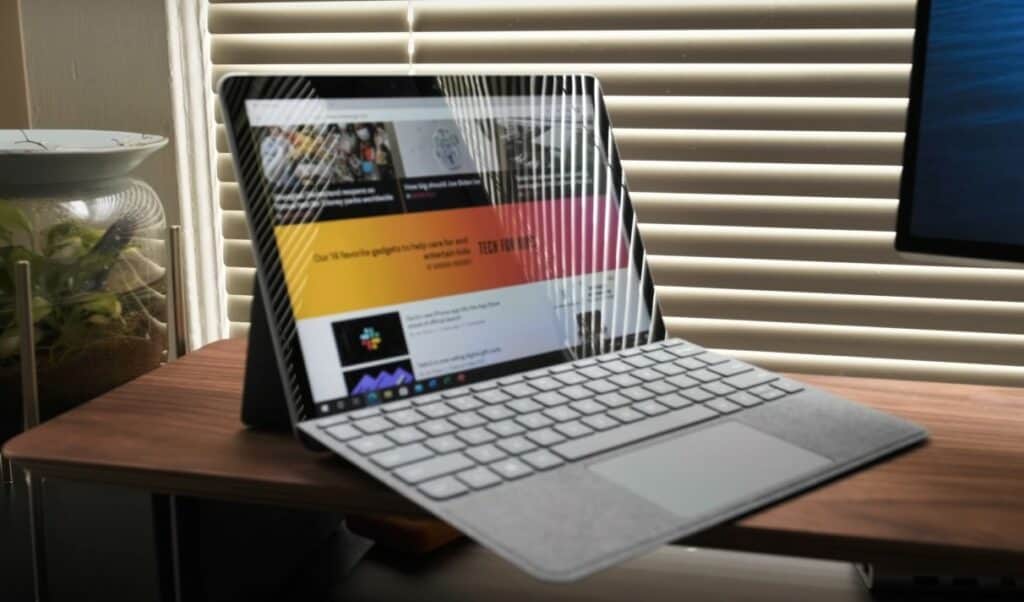
Microsoft’s Surface Go 2 was quite an improvement compared to the 1st-gen Surface Go. Released in May 2020, it can still handle just about any daily task you throw at it. Running an upgradeable Windows 10 Home S, it comes in several variants depending on your CPU of choice, how much RAM and storage you want, and whether or not you need a cellular connection.
Pros:
- Solid design
- Responsive display
- Solid performance
- Better value for money
Cons:
- Weak battery life
- Lower performance
Surface Go 3
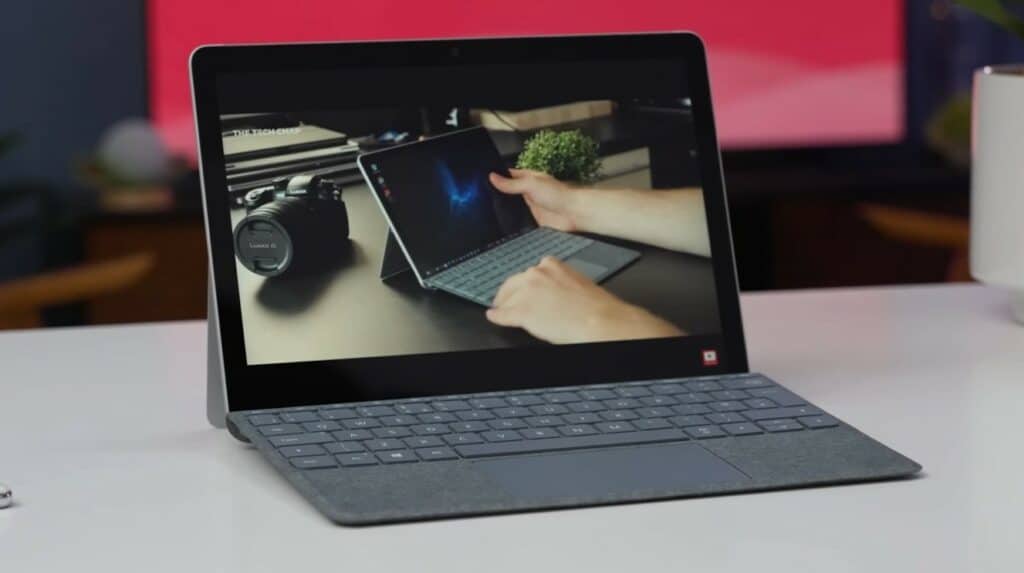
Microsoft’s Surface Go 3 is not that much of an improvement from its predecessor. Released in September 2021, it offered the same display, casing, RAM and storage configurations, cameras, and networking speeds (Wi-Fi 6, Bluetooth 5.0, LTE 4G) as the Surface Go 2. The only differences are the available CPUs to choose from, and the Windows 11 Home S operating system.
Pros:
- Solid design
- Responsive Display
- Better performance
- Newer OS
Cons:
- Weak battery life
- Higher prices
| Microsoft Surface Go 2 | Model | Microsoft Surface Go 3 |
|---|---|---|
| 10.5″ PixelSense Display | Display | 10.5″ PixelSense Display |
| 1920 x 1280 (220 PPI) 3:2 | Resolution | 1920 x 1280 (220 PPI) 3:2 |
| Windows 10 Home S (upgradable) | OS | Windows 11 Home S |
| Intel Pentium Gold 4425Y 8th-gen Intel Core m3 | CPU | Intel Pentium Gold 6500Y 10th-gen Intel Core i3 |
| Intel UHD Graphics 615 | Graphics | Intel UHD Graphics 615 |
| 4 GB8 GB | RAM | 4 GB8 GB |
| SSD: 128GB, 256GB eMMC: 64GB | Storage | SSD: 128GB, 256GB eMMC drive: 64GB |
| 8.0 MP, 1080p HD | Rear Camera | 8.0 MP, 1080p HD |
| 5.0 MP, 1080p HD | Front Camera | 5.0 MP, 1080p HD |
| LTE (optional) Wi-Fi 6 Bluetooth 5.0 | Connectivity | LTE (optional) Wi-Fi 6 Bluetooth 5.0 |
| Nano SIM Tray 4G LTE | Cellular | eSIMNano SIM Tray 4G LTE |
| Li-Ion 3,500mAh | Battery | Li-Ion 3,500mAh |
| USB 3.0 3.5mm Surface Connect | Ports | USB 3.0 3.5mm Surface Connect |
| 9.65″ x 6.9″ x 0.33″ (245 mm x 175 mm x 8.3 mm) | Dimensions | 9.65″ x 6.9″ x 0.33″ (245 mm x 175 mm x 8.3 mm) |
| Wi-Fi: 1.2 lb (544 grams) LTE Advanced: 1.22 lb (553 grams) | Weight | Wi-Fi: 1.2 lb (544 grams) LTE Advanced: 1.22 lb (553 grams) |
Features Face to Face
Design
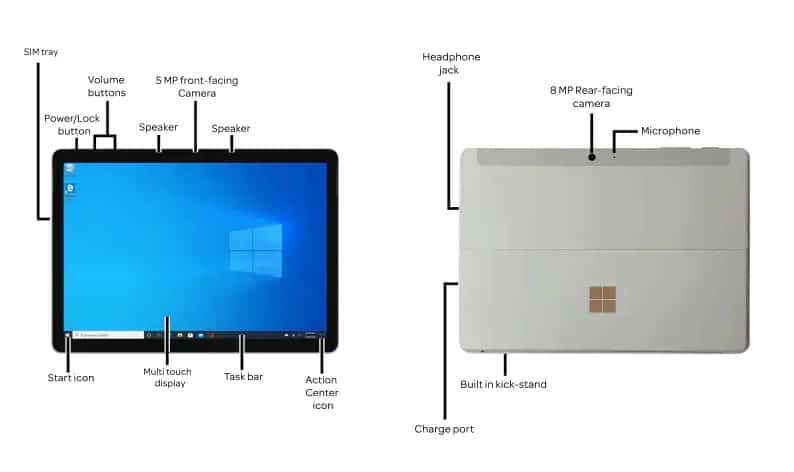
Both devices are identical in design and casing. To top that off, when I flipped them and looked at the model number, both were models 1901. Their dimensions and weight are identical (depending only on your choice between Wi-Fi only and Wi-Fi + LTE). Every button and port is in the same place on both devices.
The Surface Go 2 is available in four colors: Sage, Ice Blue, Sandstone, and Platinum. The Surface Go 3 is also available in four colors: Platinum, Cobalt Blue, Matte Black, and Sandstone.
Winner: Draw
Display
The similarities continue. Both tablets have a 10.5″ PixelSense touchscreen Gorilla Glass display with a 3:2 aspect ratio and a 1920 x 1280 resolution at 220 pixels per inch. It supports 10-point multi-touch and stylus input, such as the Microsoft Surface Pen.

Even though both tablets feature the same screen on paper, I have to admit the Surface Go 3 seems to be better calibrated in terms of brightness and contrast, and thus offers a slightly better image than the Surface Go 2.
Winner: Surface Go 3
Check out our Buying Guide for 10-inch Tablets
Audio
The built-in speakers of both tablets are what you’d expect from any tablet or 2-in-1. They’ll carry a tune so you can listen to it, but it’s nothing to brag about. Officially speaking, both are equipped with 2W stereo speakers with Dolby Audio. Thankfully, Microsoft has chosen to keep the traditional 3.5mm audio jack in both devices, enabling you to expand your acoustic experience with ease.
Both tablets have dual “studio quality” microphones placed near the front camera and one by the rear camera. Trust me, a studio-quality microphone is something quite different, but it sounds nice on paper. Anyway, they are more than enough for video calling, recording videos, etc.
Winner: Draw
Hardware
CPU
The only real choice you have to make when deciding which Surface Go is for you is the hardware setup. Both the Surface Go 2 and the Go 3 have two processors to choose from. The less powerful of the two Surface Go 2s doesn’t have a turbo frequency boost and is stuck at 1.70 GHz. The m3 Surface Go 2 offers double that, operating at 3.40 GHz when boosted.
| Model | CPU | Core Count | Base Frequency | Boost Frequency |
|---|---|---|---|---|
| Surface Go 2 | Intel Pentium Gold 4425Y | 2 | 1.70 GHz | N/A |
| Surface Go 2 | Intel Core m3-8100Y | 2 | 1.10 GHz | 3.40 GHz |
| Surface Go 3 | Intel Pentium Gold 6500Y | 2 | 1.10 GHz | 3.40 GHz |
| Surface Go 3 | Intel Core i3-10100Y | 2 | 1.30 GHz | 3.90 GHz |
In comparison, the less powerful Surface Go 3 version offers the same 3.40 GHz as does the better Surface Go 2 version. Its more powerful version, the Intel Core i3 version, offers a turbo boost reaching 3.90 GHz. This results in noticeably faster OS loading times and a more streamlined user experience overall.
RAM
Another choice you can make is the RAM configuration. Both the Surface Go 2 and the Go 3 are available with 4 or 8 GB LPDDR3 RAM configurations operating at 1,866 MHz. This determines whether you will end up with a 32 or 64-bit Windows OS.
Graphics
These are not gaming tablets, but as Windows-based machines, they can run many games, mostly old or resource-light. Both feature Intel UHD Graphics 615 as part of their CPU. The Surface Go 3 has the upper hand here as well.
| CPU Version | Base Clock Speed | Boost Clock Speed |
|---|---|---|
| Intel Pentium Gold 4425Y | 300 MHz | 850 MHz |
| Intel Core m3-8100Y | 300 MHz | 900 MHz |
| Intel Pentium Gold 6500Y | 300 MHz | 900 MHz |
| Intel Core i3-10100Y | 300 MHz | 1,000 MHz |
Winner: Surface Go 3
OS and Software
The Surface Go 2 is equipped with a Windows 10 Home S OS, which can be upgraded to Home or Pro versions. You can also install Windows 11 on the Surface Go 2, bringing it to the same OS level. The Go 3 features Windows 11 Home S, upgradeable to Home or Pro.
As Microsoft devices, both tablets feature built-in software such as Microsoft Office, Microsoft 365 (trial version), Skype (1-year free international calls), Microsoft Edge, and much more. I tried installing my browser of choice (Google Chrome) and was disappointed by the performance and lag I experienced on both tablets.
Winner: Surface Go 3
Our 2023 Guide: Best Windows Tablets
Performance
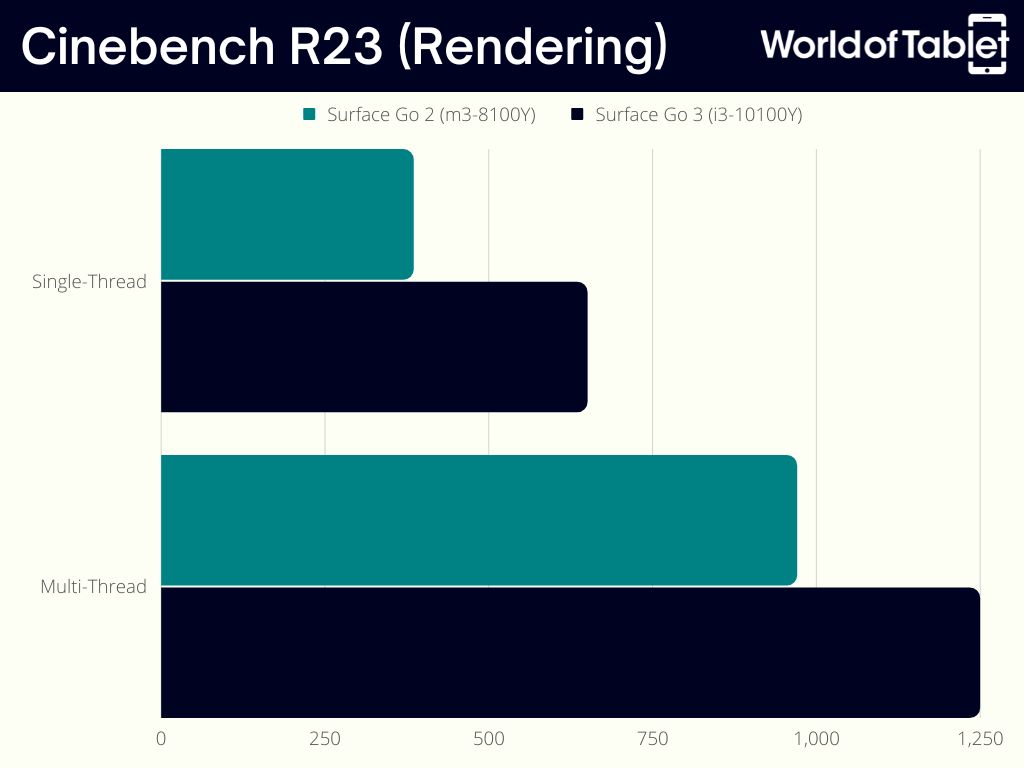
You’ll experience different performance results depending on your configuration, but I tested the best against the best. So, the Go 2 with 8 GB RAM and m3 CPU against the Go 3 with 8 GB RAM and the i3 CPU. And no surprises here. The Surface Go 3 outperforms the Go 2 in almost every aspect. You can also use Nvidia GeForce NOW to get around any performance limitations.
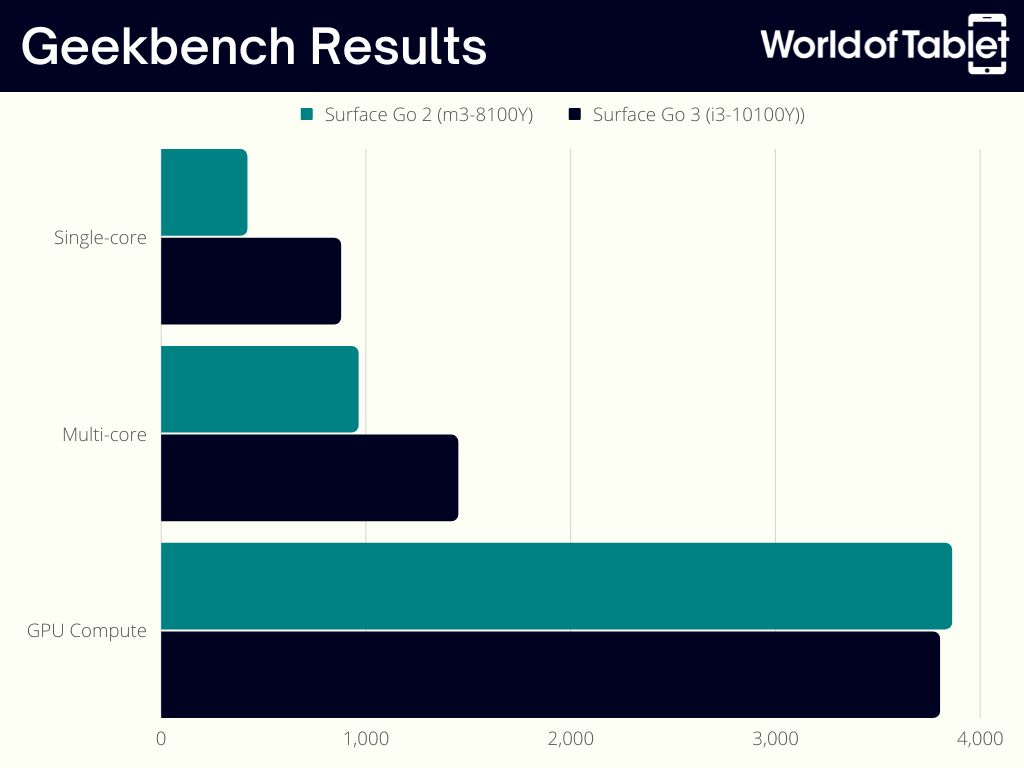
The i3 CPU delivers 85% better single-thread performance than the m3. This difference drops to 28% for multi-thread results. Geekbench results paint a similar picture, with a 108% advantage for the i3 in single-core performance. This drops to 50% for multi-core performance. GPU performance is the only surprise for me. I expected results to favor the i3, but the m3 beat it by 1.5%.
Winner: Surface Go 3
Need a gaming tablet? Read Our Best Gaming Tablets Guide.
Cameras
Both tablets feature a 5MP front camera capable of 1080p video recording. It’s a highly-praised camera for video calls and includes Windows Hello face authentication for security. The rear camera of both tablets is an 8MP auto-focus camera with 1080p video capabilities, as well.
Winner: Draw
Accessories & Peripherals
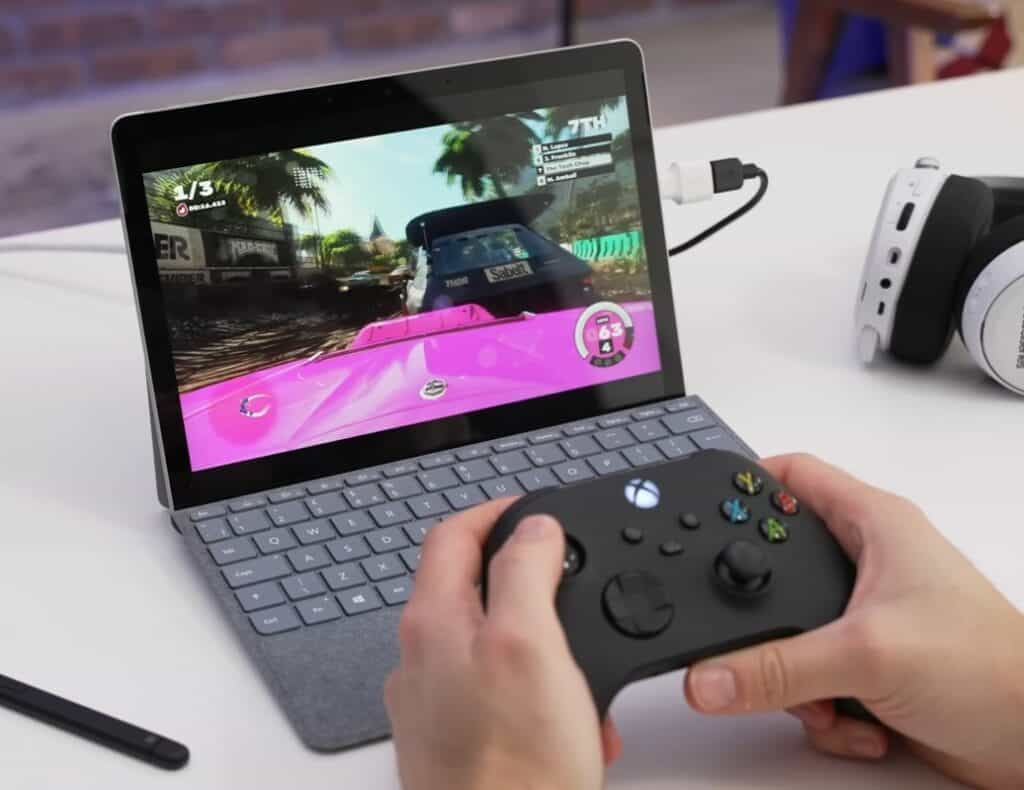
Surface Go’s appeal comes in part from being a 2-in-1 tablet. You should note that all accessories, such as keyboards and Pens, are usually sold separately. The most notable accessory is the keyboard which is compatible with every Surface Go generation. There’s a multitude of manufacturers to choose from, and this is a must-have accessory for any Surface Go tablet.
Winner: Draw
Looking for a typing tablet? Read Our Best Tablets With Keyboards Guide
User Interface (UI)
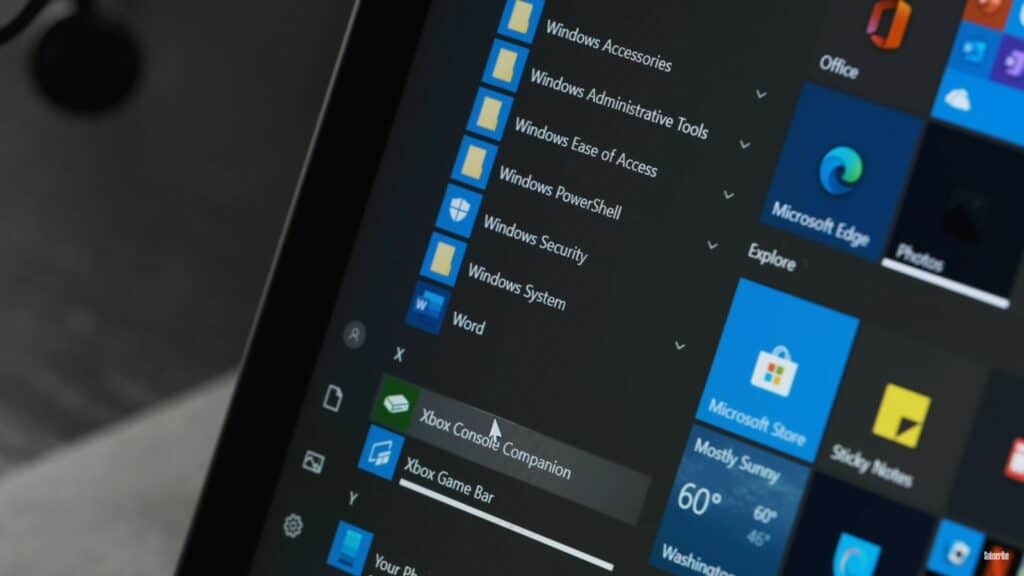
UI differences between these tablets are obvious because the Surface Go 2 has Windows 10, and the Go 3 has Windows 11. Windows 11 isn’t much of an upgrade from Windows 10, except aesthetically. For a long-time Windows user such as myself, Windows 10 is more appealing.
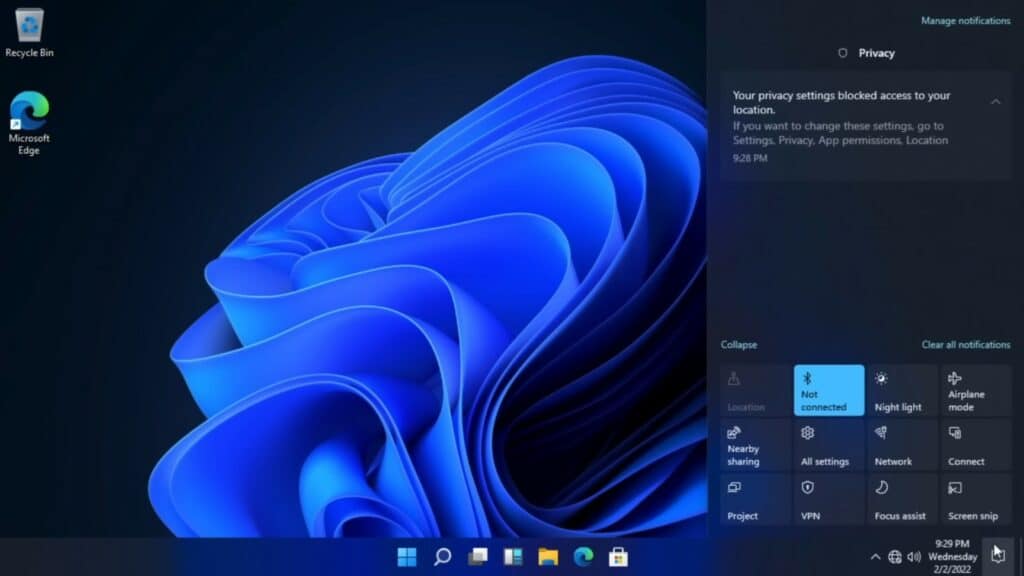
You can install Windows 11 on your Surface Go 2, bringing it on par with the Go 3 if that’s what you’re after. No need to move to a new device in search of a new UI.
Winner: Draw
Battery
Both tablets are equipped with a “10-hour long under typical use” Li-Ion 3,500 mAh battery, which is a very low-capacity battery, frankly. My phone has 4,500 mAh. This was surely one aspect in dire need of an upgrade, but Microsoft failed to deliver. The majority of 10-inch tablets feature 4700 mAh on average.
Winner: Draw
Storage
Both tablets have several storage configurations — 64GB (eMMC), 128GB (SSD), and 256GB (SSD). Both have MicroSD slots for additional storage upgrades. The Surface Go 2 supports up to 2TB, while the Go 3 supports 512GB.
Winner: Draw
Connectivity
Without cellular connections, tablets lose most of their appeal. Thankfully, both the Go 2 and the Go 3 have LTE versions that support 4G networks. They also both have Wi-Fi 6 and Bluetooth 5.0.
Winner: Draw
Surface Go 2 vs Surface Go 3 – Quality and Reliability
Warranty & Customer Support
Microsoft offers up to four years of Hardware Service warranty, depending on your purchase. Microsoft warranty is a “sold separately” item. You can reach customer support in several ways, and Microsoft has a support page with a ton of resources to help you with your Surface Go tablet.
Winner: Draw
Price
Purchasing a new Surface Go 2 is still possible, and it’s noticeably cheaper than a new Surface Go 3. As the Surface Go 3 is not much of an upgrade from the Go 2, there’s no need to shell out for it. You can grab a fully-loaded Surface Go 2 (256GB) at half the price of a 128GB Surface Go 3. Keyboards and Pens are sold separately.
Conclusion
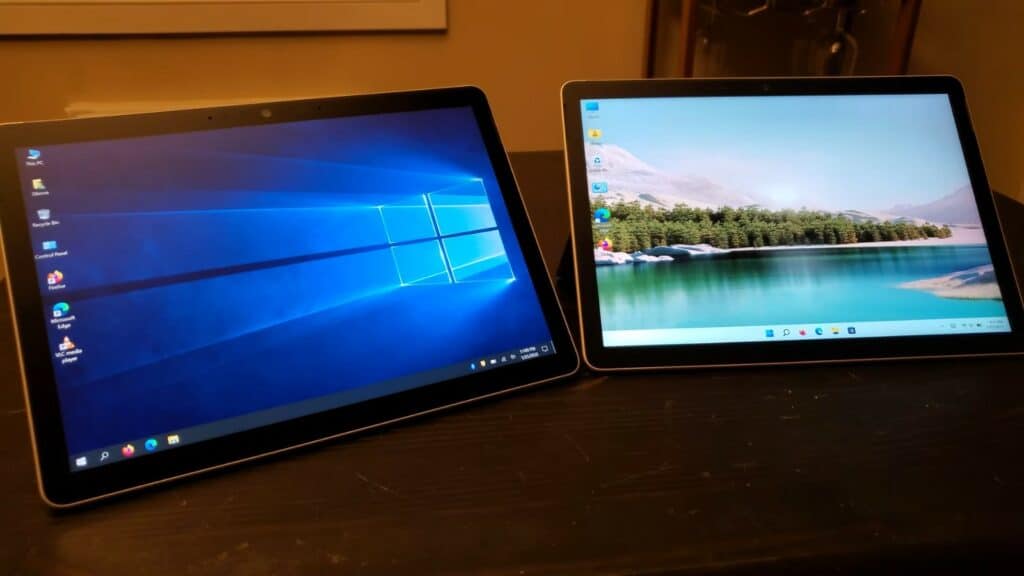
If this Surface Go 2 vs Surface Go 3 comparison has shown anything, it’s that upgrading from one to another is pointless. While the Surface Go 3 has better performance, it’s not that noticeable when using them side by side. Yes, the Go 3 loads Windows faster, but you do that once or twice a day. Browsing is very similar on both, as is watching HD videos, or typing for that matter.
If you’re hell-bent on purchasing a Surface Go tablet, take my advice and get the older Go 2 version. If you already have a Surface Go 2, don’t bother upgrading. Wait it out for the Surface Go 4, I’m sure Microsoft will release it this year.

Leave a Reply